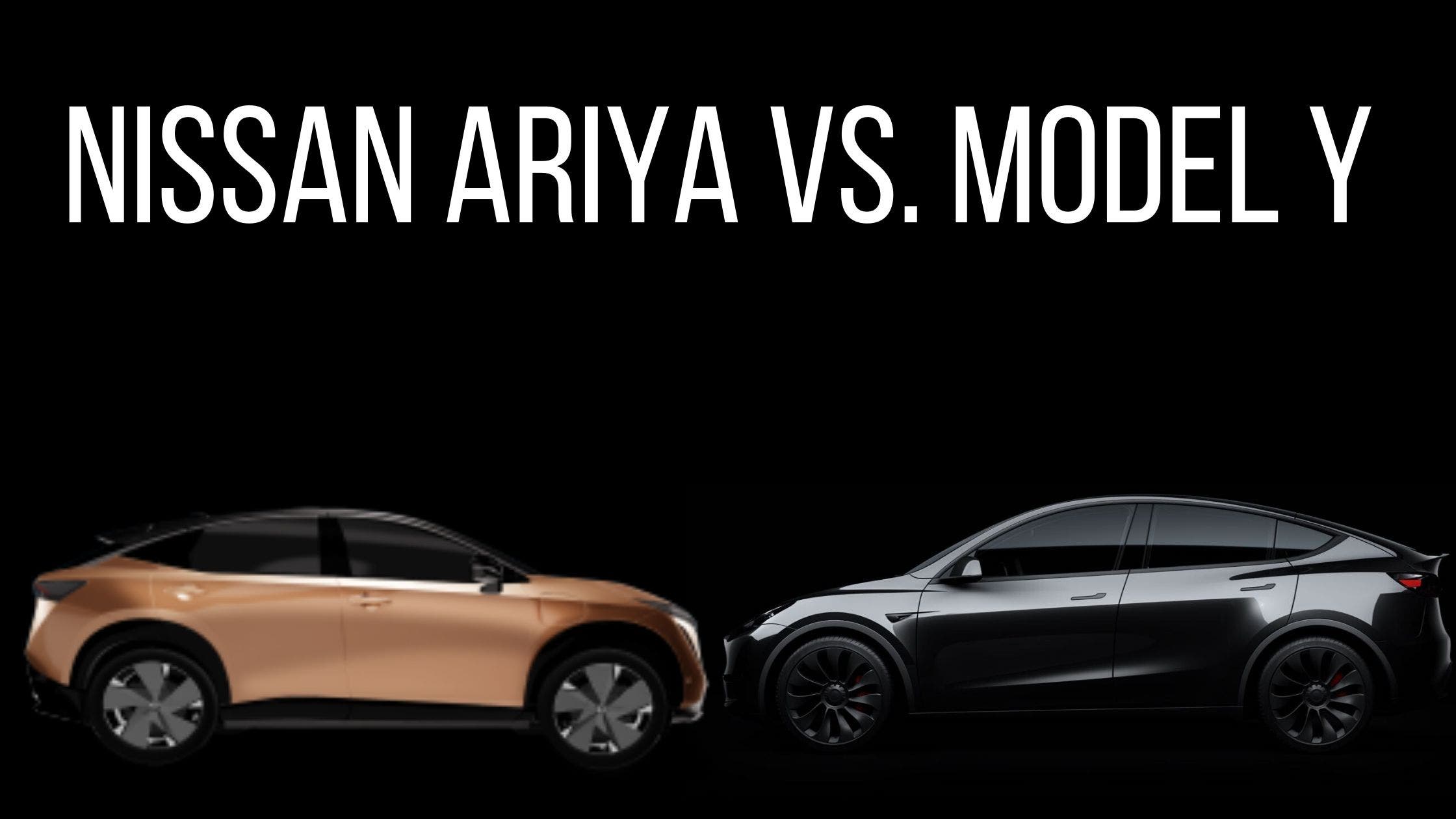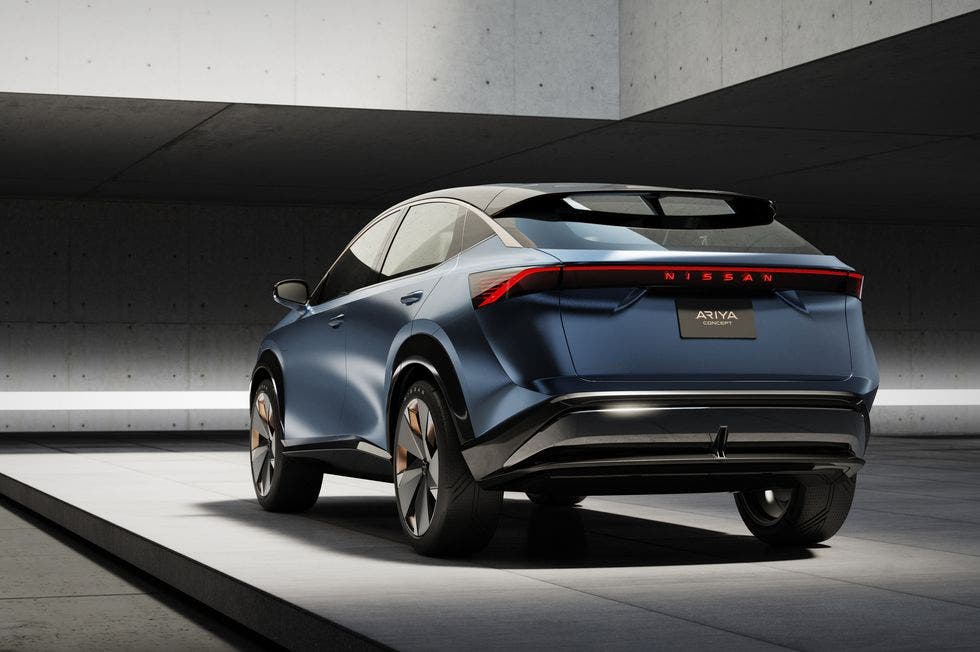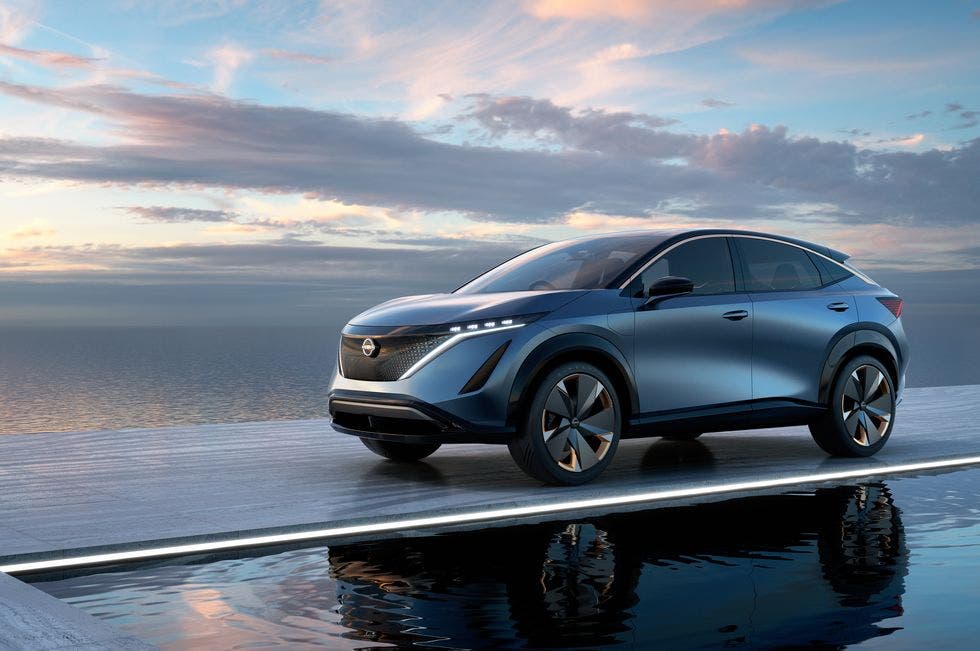Implications Of The Nissan Ariya … And No, It’s Not A Tesla Killer

July 18th, 2020 by Frugal Moogal
Okay, let’s get this out of the way right away — no, the Nissan Ariya is not a “Tesla Killer.” I couldn’t resist mentioning that term in the headline because it seems to be what every mainstream news site calls every new electric vehicle revealed by legacy auto.
As I write this, Tesla’s market cap is $286.59 billion, compared to Nissan’s market cap of $32.79 billion, so the whole theory that any halfway capable electric car will “kill” Tesla is now a clear joke, or should be. Legacy auto let the moment pass in which it could have really challenged Tesla by making compelling products.
Instead of being branded a “Tesla Killer,” I’ve seen a number of articles wondering if the Ariya will be the car that could give Nissan a future. That is perhaps a better way to look at it.
To be clear, Nissan has had a ton of problems. Its former chairman, Carlos Ghosn, was arrested and jailed for several months in Japan and then snuck away in some kind of bonkers Oceans 11–style caper that involved him hiding in a large musical instrument case. Nissan’s sales and market share collapsed after that. And all that happened before the pandemic hit legacy auto hard.
With that backdrop, let’s take a look at Nissan’s latest EV offering and what it may mean for Nissan as a company.
Before going on, if you’re looking for a straight Ariya overview, here’s the Cleantechnica article you want. I’m attempting to look at the Ariya and what it means for Nissan, as that’s the sort of thing I tend to do in my articles.
The Nissan Leaf
To really understand the Ariya, I feel we need to look at the Leaf first. Nissan was the leader in affordable EVs with the Leaf. The Leaf is a solid second car. My family owns one. As I explained in a previous article about why I find Tesla’s financial success so important to the future of clean technology, my experience sharing the cost breakdown of the Leaf followed by so many of my friends purchasing them led to the local dealership literally calling me to ask if I knew someone else who might be looking for one whenever they got one in on trade.
The problem, however, was the first-generation Leaf was only really an around-town car, and Tesla took many of those early adopters when it released the Model 3. On the Q2 2018 earnings call, Tesla noted the Leaf was one of the five most commonly traded in vehicles for the Model 3. Nissan’s EV star was reduced to a stepping stone for another brand.
I first heard rumors of the Ariya in 2017. Shortly after we had purchased our Leaf, I took it in to upgrade its computer so my phone could connect to the app and asked to talk to someone about the new Leaf. I ended up being friends with the one salesperson there who followed their EV program.
And this is the first concern I have about the Ariya: From what I’m told, this is the general way Nissan has set up its dealerships, where only one or two people know anything about their electric offering(s), and they won’t bring it up unless specifically asked. It’s hard to sell a car when you have to beg the dealership to show it to you.
I told this salesperson I wanted a long-range electric car, and I wanted it to be a Nissan since I wasn’t so sure Tesla would stick around. He told me — honestly — that the newer Leaf wouldn’t do it, but said Nissan had told their EV team about an electric vehicle based on the Rogue that would probably meet my needs. He told me he’d contact me when he heard a release date, and he was pretty sure he’d know that date before I got my Model 3.
18 months later, when I got my Model 3, he privately told me it was the right choice, as he had heard nothing about the “Rogue EV,” as he called it, being pushed forward.
I don’t know that the Ariya is the Rogue EV — in fact, I’m pretty sure it’s not, as I’ll explain in a moment, but it continues a string of disappointments that I’ve had with Nissan. It feels like, since around 2013, Nissan has actively fought against reasons to upgrade its Leaf tech and really make it a stand out.
And, to be fair, I drove a newer Nissan Leaf at the behest of my dealer friend — he asked me to drive it after I got the Model 3 to give him my real thoughts on it. It’s a solid car! I loved the one-pedal driving option that Tesla didn’t have at the time, and I would have considered it had I felt like Nissan cared about the tech powering it. I was comfortable with Nissan as a brand.
So now — erm … next year — the Ariya arrives, about 10 years from when Nissan released the Leaf in the US. Will it return Nissan to electric prominence?
The Nissan Ariya
The Ariya sits on a new EV platform. That’s positive news, as perhaps the biggest knock on the Leaf has been that its battery system wasn’t actively cooled during charging. Even when Nissan finally upgraded the system to air cooling in its “e-Plus” cars in 2019, Nissan continued to have issues.
Let’s be frank — if the Ariya was based on the Leaf’s architecture, it would be clear Nissan still had no further EV plans. The fact it isn’t is positive.
The one red flag I see is the Ariya doesn’t have a frunk. Now, you don’t need to have a frunk to have a successful EV, but I wonder how many of the systems have been redesigned to efficiently fit in the vehicle when the entire space under the hood will apparently be filled with them. I also wonder how this will affect safety and crumple zones. Seems like a system designed from the ground up could better optimize its space, but I’ll reserve final judgment until I can see one first hand.
Nissan will offer the Ariya in two trim levels, a front wheel drive variation and an “e-4ORCE” variation, since, apparently, “all wheel drive” is too confusing or something.
How the Ariya Stacks Up — Cargo Volume / Overall Size
We’ve got to start by seeing what we can compare the Ariya to, and this is where I was really surprised to see that the Ariya is only slated to have 16.5 cubic feet of cargo volume in the front wheel drive variation of the car. The e-4ORCE version is even worse, clocking in at 14.6.
This does not put it in Rogue territory, as the Rogue has 39.3 cubit feet of cargo volume. I believe it’s considerably less than the Model Y’s space — Tesla, oddly, doesn’t share the Y’s capacity with the seat up, but its seat-down capacity nearly matches the Rogue’s seat-down capacity. The Ariya offers about half of the Mustang Mach-E’s space, which is slated to have 29 cubic feet. In fact, the Ariya aligns almost perfectly with the 15 cubit feet of the Model 3.
The height of the car is bigger — the Ariya is 8″ taller than a Model 3 — but it’s about 3″ shorter.
This means a few things, but the first thing that stands out to me is the Ariya won’t really compete against Nissan’s other vehicles. I take it as sign of legacy auto figuring EVs will just appeal to treehuggers who don’t mind paying a “green tax” to get a vehicle that doesn’t run on fossil fuels. The Ariya will be sitting across from the Rogue in showrooms with a starting cost about $15,000 above it (before tax credit), with storage space that doesn’t come close to matching it, and with salespeople who don’t know much about EVs and have to go get “the guy” who does.
At least Ford is plastering the Mustang name on its upcoming EV to get some attention, but as much as I want the Ariya to thrive, I don’t think this will be a revelation in US or European showrooms.
Maybe that’s okay, as long as the Ariya shows some advancement in my key metrics for EVs — battery capacity and efficiency. This is where I always start with new cars. You can look at my Mustang Mach-E battery dive as well as my Tesla Cybertruck one for other examples. I’ve heard a ton from Tesla [TSLA] bears claiming that Tesla has absolutely no technological or battery advantage. Let’s see if that appears to be true under the hood.
How the Ariya Stacks Up — Battery Capacity / Efficiency
I am constantly surprised by how little importance most auto analysts give battery capacity and efficiency. They tend to look at range, and figure that if a car matches in range, the tech must be about the same.
This is a terrible way to look at vehicles. The less efficient a car is, the larger the battery will be for it to go the same distance. The larger the battery is, the longer it will take to charge, even if it is using the same charging network. And, perhaps the most important, the more expensive it will be for a company to build.
Nissan gave us two sizes for the Ariya’s batteries — 65 kWh battery (with 63 kWh of usable space) and 90 kWh battery (87 kWh usable). For the smaller battery, Nissan claims a range of 200 miles for all wheel drive (e-4ORCE, if you apparently don’t know what all wheel drive means or need a little marketing lingo tossed in) and 210 miles for front wheel drive. The larger battery is expected to clock in at 270 miles for it’s all wheel drive range (e-4ORCE, because e-4ORC3 would have been a step too far) and 300 miles for it’s front wheel drive range.
If we compare the Ariya to the similarly sized Model 3 — or, for that matter, the Model Y, with it’s massively larger cargo space — we see just how far ahead Tesla is with its tech, and the huge mountain that legacy auto has to overcome. Since there is no “Standard Range” version of the Model Y, I’m going to use the Model 3 to compare battery size to the Ariya.
The Standard Range Plus version of the Tesla Model 3 uses one motor rather than two motors as in the Long Range version. (I’m disappointed Tesla doesn’t call all-wheel drive 3-FORC3 so I can understand these things better … ha! Okay, okay, enough e-4ORCE jokes … maybe ….). The Standard Range Plus achieves a range of 250 miles per charge on a 50 kWh battery.
If we assume batteries will cost Nissan $100 per kWh next year when the Ariya goes on sale, the extra 15 kWh of battery capacity will cost Nissan an extra $1,500 per vehicle for the 65 kWh battery. It still achieves a range 16% lower than the Model 3. To equal the range of the Model 3, assuming no penalty due to the additional battery weight, Nissan apparently would actually need to use a 77 kWh battery in the standard range Ariya to reach 250 miles of range.
This is … not great for Nissan. If you’re looking at $1,500 and thinking it isn’t that big a deal, I urge you to look at my roller coaster capacity example, where we see that seemingly small changes can lead to huge differences. If Tesla had to spend an extra $1,500 on the 90,650 vehicles it produced in Q2 2020, that’s an additional cost of $135,975,000 ($136 million) for batteries.
If the Ariya matched the Model 3 in range with the 77 kWh battery pack, Nissan would be spending an additional $2,700 per vehicle just to equal Tesla’s actual range. If Tesla produces 400,000 cars this year, its efficiency gains will save the company over one billion dollars compared to what Nissan would have to do to match the Model 3’s range with this design.
I think it’s pretty clear Nissan doesn’t intend to sell many of these in the US or Europe, and I expect it would be battery constrained even if it wanted to. If it’s a hit, though, the battery capacity will hurt Nissan in another way — every 100 standard range Nissan Ariyas that are made could instead make 130 standard range Tesla Model 3s.
There is, however, one bright spot for Nissan.
The Ariya in Japan
In case it isn’t clear, I don’t think the Ariya will compete much in the US or Europe, but Nissan is planning to launch the Ariya first in Japan, and that means this car could still be very successful for Nissan.
The Japanese market is famously difficult market for foreign automakers to make a mark in. My favorite stat to demonstrate this is that General Motors sold “about 1,000” vehicles in Japan in 2016. By contrast, in April of 2018, Nissan celebrated selling over 100,000 Nissan Leafs (Leaves?) in Japan. Also, as we reported last night, approximately 90% of imported electric vehicles sold in Japan last year were Teslas, but that total was just 1,378. This is despite the Japanese auto market being the third largest in the world.
With few all-electric offerings in Japan, the Ariya stands to gain a foothold there if it’s positioned correctly. For Nissan’s sake, I hope so.
Conclusion
Make no doubt about it, the Ariya continues to show how Tesla is absolutely dominating the electric vehicle industry, and shows just what a mountain legacy auto has to climb. It looks like a fine vehicle — secretly being a bit smaller than it appears — but it will face competition from its own vehicles on the lower end, and will start above the price of the similarly sized Model 3 on the higher end.
I honestly don’t think the Ariya will sell well in North America or Europe. Nissan’s deficiencies in its available charging infrastructure and dealership network will be barriers to sales. Competitors to the Ariya — namely, the Tesla Model 3 and Model Y — already have charging infrastructure and sales network advantages. And Tesla has huge efficiency benefits.
But Japan may be where it’s at. The Ariya appears to be a significantly better car than the original Leaf, and it may give Nissan an advantage in a segment almost all other major Japanese automakers have largely been ignoring.
But is it enough? It’s hard to say. Japan only managed to sell 43,867 cars with plugs last year, for a terrible market share of 0.8% total, and the 2020 figure is at 0.7% so far. And this number includes PHEVs like the Toyota Prius Prime and Mitsubishi Outlander PHEV.
I’m hoping the Ariya can kick off an electric revolution in Japan, though. Nissan’s future may depend on it.
Disclaimer
I am a Tesla [NASDAQ:TSLA] shareholder who has purchased shares within the preceding 12 months. I am not a Nissan shareholder, nor do I intend on becoming one. Research I do for articles, including this article, may compel me to increase or decrease stock positions. However, I will not do so within 48 hours after any article is published in which I discuss matters that I feel may materially affect stock price. I do not believe that my voice could or should influence stock price by itself, and I strongly caution anyone against using my work as your sole data point to choose to invest or divest in any company. My articles are my opinion, which was formulated using research based on publicly available data. However, my research or conclusions may be incorrect.
Latest CleanTechnica.TV Episode
Latest Cleantech Talk Episode

Twitter fan. Beer specialist. Entrepreneur. General pop culture nerd. Music trailblazer. Problem solver. Bacon evangelist. Foodaholic.










